Passenger cars
Severe hybrid engine oil testing
20 May 2025
18 July 2023
Assessing the potential implications for automotive engine lubricants

According to the European Commission, road transport is the largest source of air pollution in cities. To ensure cleaner vehicles on its roads, to improve air quality and to meet the European Green Deal's zero-pollution ambition, the Commission has proposed the Euro 7 emissions standard for new cars, vans, lorries and buses sold in the European Union. Infineum’s Uwe Zimmer and Etienne Martin explore the Euro 7 proposal and the potential impacts on future light-duty and heavy-duty engine lubricants.
The content and timing of Euro 7 have been topics of much speculation over a long period of time. But, on November 10 2022, the European Commission (EC) lifted the veil, publishing the Euro 7 proposal. Before looking into the technical details and its potential impact on lubricants, it is important to understand Euro 7 is still a draft. Prior to adoption it must go through the ordinary legislative procedure under the Lisbon Treaty in the European Parliament and the EC.
Opinions about the proposed Euro 7 standards are as diverse as can be expected from a very broad set of stakeholders.
These range from “not ambitious enough”, “completely unrealistic” through to “detrimental to transport sector decarbonisation”. In other words the Euro 7 situation remains fluid as details and implementation plans are refined, and as stakeholders continue to lobby, while the legislative process progresses towards negotiations between the Commission, the Parliament and the Council.
The general objectives of Euro 7 are to reduce the complexity of current emissions standards, provide up-to-date limits for all relevant pollutants and improve control of real-world emissions. The Euro 7 proposal replaces previously separate emission rules for cars and vans (Euro 6) and lorries and buses (Euro VI), bringing emission limits for all these motor vehicles under a single set of rules.
The new rules are fuel- and technology-neutral, placing the same limits regardless of whether the vehicle uses petrol, diesel, electric drivetrains or alternative fuels. In addition, durability requirements have been extended and, on this point, it is worth noting that Euro 7 also specifies durability requirements for batteries. Rules for non-exhaust emissions - equally applicable to all vehicles regardless of propulsion system - were also added.
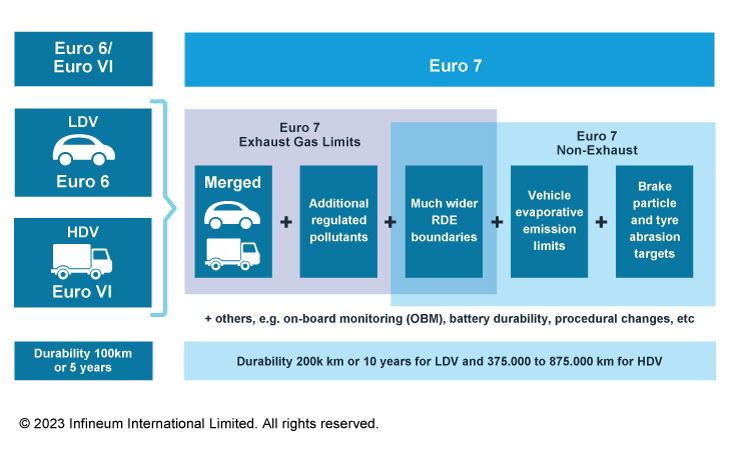
Perhaps one of the most impactful changes introduced with Euro 7 is the shift from laboratory-based engine testing to real-driving emissions (RDE) testing under wider RDE boundaries.
According to the proposal, the Euro 7 regulation will enter into force on July 1 2025 for new light-duty vehicles and July 1 2027 for new heavy-duty vehicles.
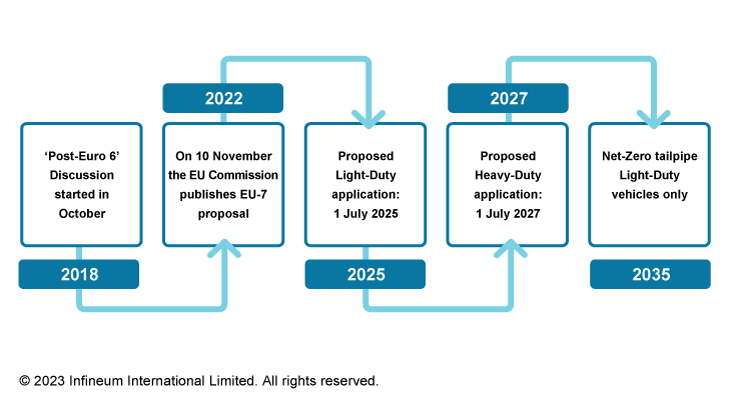
As part of Europe’s decarbonisation actions, light-duty vehicles with an internal combustion engine (ICE) can only be registered after 2035 if they run exclusively on CO2 neutral fuels. This could make these Euro 7 emissions standards the last in Europe to specify light-duty vehicle exhaust gas limits.
The relatively small applicable Euro 7 fleet has fuelled discussions about the positive impact this regulation can be expected to have on the environment versus the technology advancements and investment efforts required.
Euro 7 is fuel agnostic and, in general terms, the most severe Euro 6d limits for diesel or gasoline (highlighted in red) have been carried over to Euro 7. A new limit for ammonia (NH3) has been introduced. Also new is a new limit ‘architecture’ with a budget limit for all regulated pollutants for the first 10 km per trip (Emission Budget); above 10 km the limits per km as shown in the table below apply.
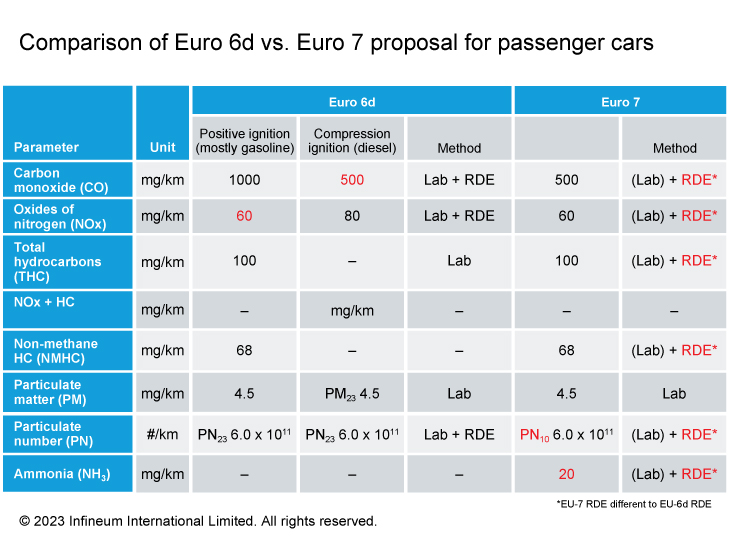
However, some significant changes are less obvious:
| NOx | Nominal 25% reduction for compression ignition (diesel), also a reduction of the conformity factor (CF) from 1.43 to 1 (-30%). A CF of 1 means NOx emissions as per Euro 7 legislation cannot be higher when measured on road under the prescribed conditions (RDE vehicle testing) than in the laboratory. |
| PN | Now covers particles ≥ 10 nm (previously ≥ 23 nm in Euro 6d); this leads to a significantly higher particle count. Furthermore, as for NOx, the CF has been reduced to 1 which brings an additional increase in severity. |
Euro 7 is still in draft status and individual OEMs may come up with different solutions to the challenges. Understanding the full impact on the lubricant will therefore be an iterative process. However, likely implications can be extracted from the current Euro 7 proposal. The table below summarises how lubricant requirements could develop as a consequence of its introduction.
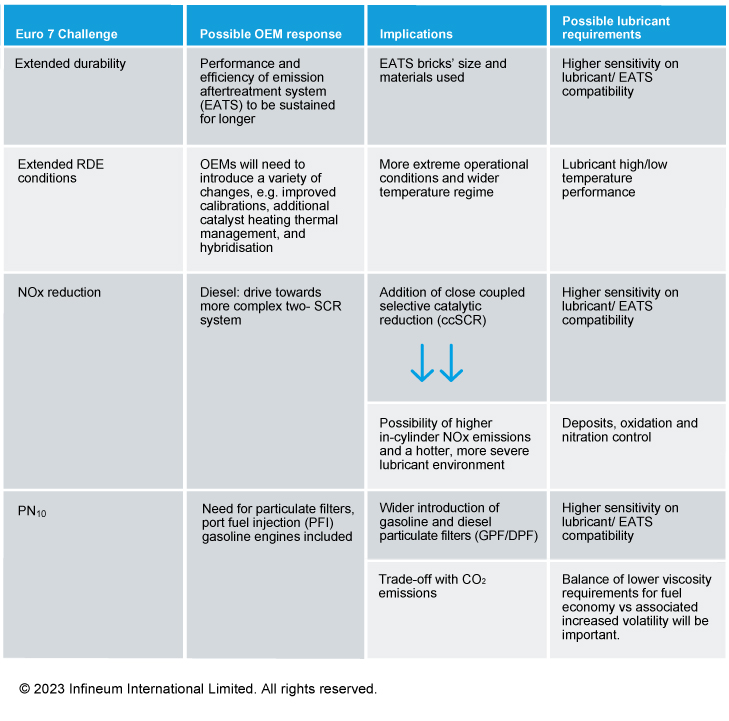
For heavy-duty vehicles, just as for light-duty, Euro 7 shifts the focus from laboratory-based engine testing to RDE vehicle testing. However, a direct comparison of Euro VI with Euro 7 is more difficult for heavy-duty. First because Euro 7 limits of pollutants already regulated under Euro VI have been tightened, and second, additional pollutants nitrous oxide (N2O), non-methane organic gases (NMOG), Formaldehyde (HCHO) and PN covering particles ≥10 nm PN10 have been included. And lastly, RDE conditions have been widened as Euro 7 regulates cold and hot emissions separately for heavy-duty vehicles.
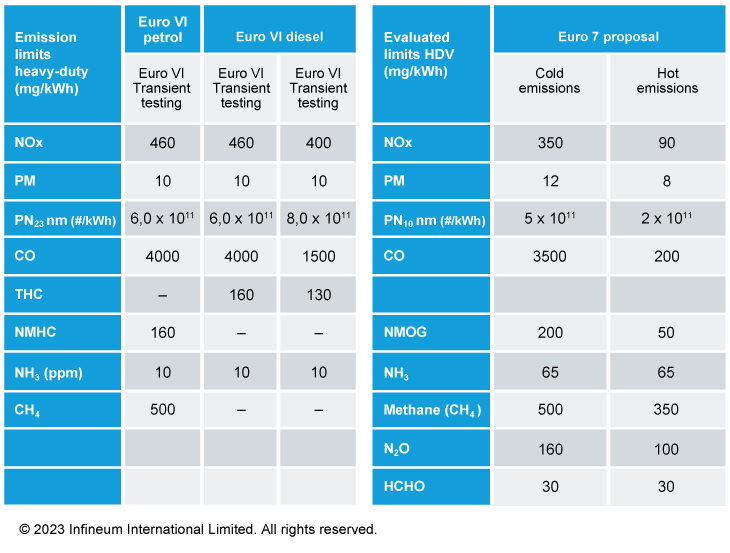
Comparatively, these new heavy-duty vehicle regulations are more stringent than those for light-duty vehicles. In addition, since heavy-duty vehicles are more challenging to electrify than smaller modes of transport, the ICE is expected to be the powertrain of choice for many years to come. As a result it is likely that Euro 7 will drive substantial changes and bring new technologies to the market. In our view, meeting the severe NOx limits for both hot and cold conditions will be one of the biggest challenges.
Along with the same potential impacts already flagged for light-duty diesel engines, in the heavy-duty world we can expect to see additional challenges. The table below summarises the way heavy-duty lubricant requirements could develop as a consequence of Euro 7 introduction.
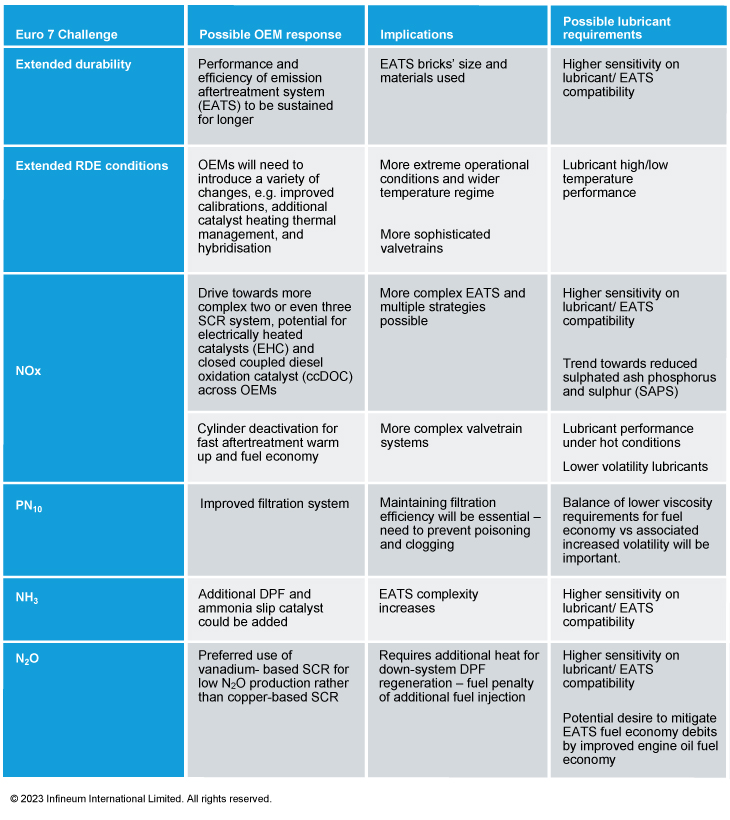
Euro 7 is a legal requirement – making it a ‘must have’ for OEMs who wish to maintain and grow their revenues, not least to help fund the transition to zero-emission vehicles.
Passenger car OEMs in particular may have to reallocate resources back to the ICE to get ready for Euro 7. This is likely to be combined with a review of their ICE portfolio with a trend towards rationalisation. The segment of small ICE powered vehicle will be under growing pressure since the cost of Euro 7 compliance will be relatively higher for these vehicles. In the heavy-duty world, which is less easily electrified and where ICE sales are likely to account for most of the revenue in the decade to come, we can expect OEMs to dedicate significant resources towards Euro 7 compliance preparation.
Infineum’s impact assessment clearly shows that lubricants have a role to play in the Euro 7 context.
In support, Euro 7 compatible lubricants will be required well in advance of the application dates to give OEMs time to validate their Euro 7 hardware and calibrations with these lubricants. However, with currently proposed Euro 7 introduction timings, there is insufficient time for fundamentally new lubricant developments.
As highlighted earlier in this article, Euro 7 is not done and dusted since it still has to go through the ordinary legislative procedure. Currently the Parliament and Council are negotiating their own positions ahead of joint discussions. Media reports in May indicate that eight EU member states, a potential blocking minority in the Council, have expressed opposition to new exhaust gas emission rules as such and in particular regarding the timings.
Euro 7 is one of the many challenges OEMs are facing. The advanced ICE technology will need to be supported by advanced lubricant technologies, but neither can be developed in isolation or overnight. Infineum is committed to working with its OEM and industry partners to address the challenges ahead for a sustainable future.
Sign up to receive monthly updates via email